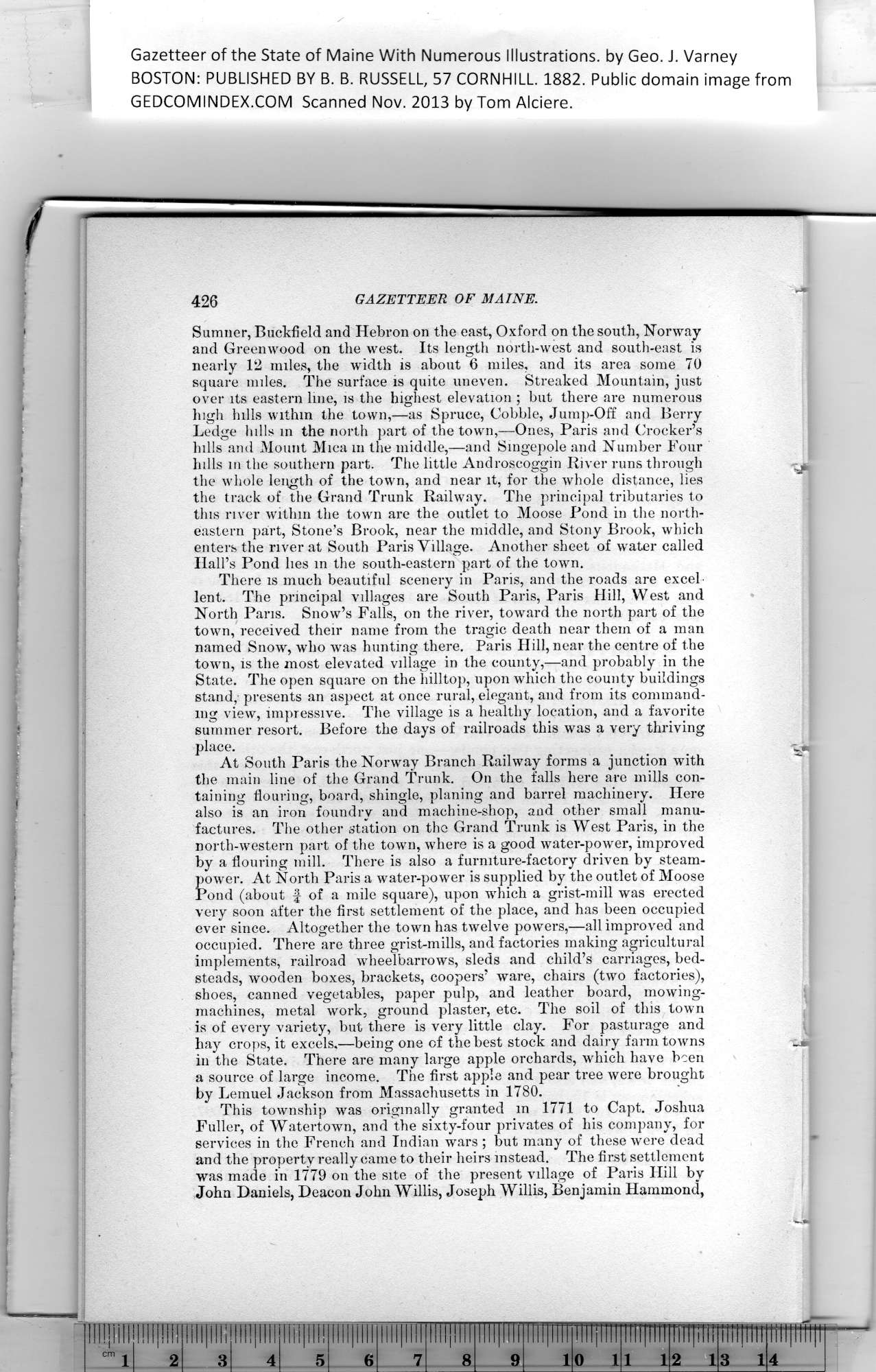|
Gazetteer of the State of Maine With Numerous Illustrations, by Geo. J. Varney
BOSTON: PUBLISHED BY B. B. RUSSELL, 57 CORNHILL. 1882. Public domain image from
426 GAZETTEER OF MAINE.
Sumner, Buckfield and Hebron on the east, Oxford on the south, Norway
and Greenwood on the west. Its length north-west and south-east is
nearly 12 miles, the width is about 6 miles, and its area some 70
square miles. The surface is quite uneven. Streaked Mountain, just
over its eastern line, is the highest elevation ; but there are numerous
high hills within the town,—as Spruce, Cobble, Jump-Off and Berry
Ledge hills in the north part of the town,—Ones, Paris and Crocker’s
hills and Mount Mica in the middle,—and Singepole and Number Four
hills in the southern part. The little Androscoggin River runs through
the whole lepgth of the town, and near it, for the whole distance, lies
the track of the Grand Trunk Railway. The principal tributaries to
this river within the town are the outlet to Moose Pond in the north-
eastern part, Stone’s Brook, near the middle, and Stony Brook, which
enters the river at South Paris Village. Another sheet of water called
Hall’s Pond lies in the south-eastern part of the town.
There is much beautiful scenery in Paris, and the roads are excel-
lent. The principal villages are South Paris, Paris Hill, West and
North Paris. Snow’s Falls, on the river, toward the north part of the
town, received their name from the tragic death near them of a man
named Snow, who was hunting there. Paris Hill, near the centre of the
town, is the most elevated village in the county,—and probably in the
State. The open square on the hilltop, upon which the county buildings
stand, presents an aspect at once rural, elegant, and from its command-
ing view, impressive. The village is a healthy location, and a favorite
summer resort. Before the days of railroads this was a very thriving
place.
At South Paris the Norway Branch Railway forms a junction with
the main line of the Grand Trunk. On the falls here are mills con-
taining flouring, board, shingle, planing and barrel machinery. Here
also is an iron foundry and machine-shop, and other small manu-
factures. The other station on tho Grand Trunk is West Paris, in the
north-western part of the town, where is a good water-power, improved
by a flouring mill. There is also a furniture-factory driven by steam-
power. At North Paris a water-power is supplied by the outlet of Moose
Pond (about f of a mile square), upon which a grist-mill was erected
very soon after the first settlement of the place, and has been occupied
ever since. Altogether the town has twelve powers,—all improved and
occupied. There are three grist-mills, and factories making agricultural
implements, railroad wheelbarrows, sleds and child’s carriages, bed-
steads, wooden boxes, brackets, coopers’ ware, chairs (two factories),
shoes, canned vegetables, paper pulp, and leather board, mowing-
machines, metal work, ground plaster, etc. The soil of this town
is of every variety, but there is very little clay. For pasturage and
hay crops, it excels,—being one of the best stock and dairy farm towns
in the State. There are many large apple orchards, which have been
a source of large income. The first apple and pear tree were brought
by Lemuel Jackson from Massachusetts in 1780.
This township was originally granted m 1771 to Capt. Joshua
Fuller, of Watertown, and tbe sixty-four privates of his company, for
services in the French and Indian wars ; but many of these were dead
and the property really came to their heirs instead. The first settlement
was made in 1779 on the site of the present village of Paris Hill by
John Daniels, Deacon John Willis, Joseph Willis, Benjamin Hammond,
PREVIOUS PAGE ... NEXT PAGE
This page was written in HTML using a program written in Python 3.2
|
